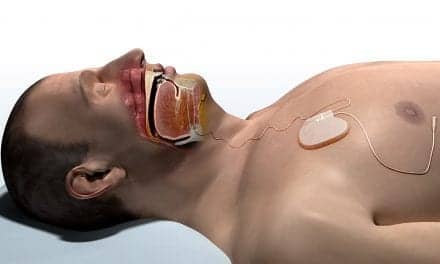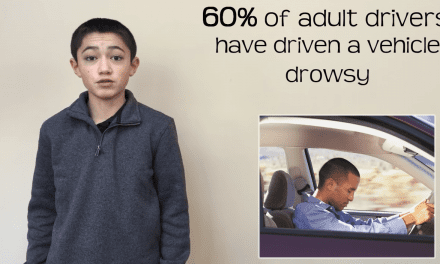According to Redondo Beach dentist Michael Fulbright, DDS, sleep apnea in children is a big problem, particularly when it goes undiagnosed or is misdiagnosed entirely. “These days, many children are being diagnosed with ADHD (attention deficit hyperactivity disorder). Some of them are acting out in school and getting in trouble. Well-meaning doctors may misdiagnose some of these children and prescribe Ritalin for ADHD, when really the cause of their behavioral problems may be sleep apnea,” he says in a release.
Sleep apnea is typically characterized by obstruction of oral and nasal passages while an individual sleeps. The condition can cause loud snoring, dangerous breathing pauses of 10 to 20 seconds or more, choking or gasping during sleep, and other effects. In children particularly, sleep apnea can lead to irritability, exhaustion, mood swings, and other problems that may not be immediately associated with a sleep disorder. And that, Fulbright says, may have lead to a diagnosis of ADHD. “A large percentage of these kids have been found to have underdeveloped mandibles or underdeveloped maxillae. These conditions can result in oral structures such as the jaws pushing back and closing the airway. When the airway is closed, they are not breathing enough—they are not getting enough oxygen… just like a regular adult sleep apnea patient. If the child has sleep apnea, they may just be tired during the day, acting out at school because they are not getting the sleep that they normally should.”
In addition to underdeveloped or irregular oral structures, Fulbright says obesity, heredity, and even exposure to tobacco smoke have been linked to sleep apnea. He notes that the condition can be the cause of severe physical and emotional health risks. However, Fulbright adds there are some advanced treatment options that can significantly reduce the symptoms of sleep apnea. One of the more common for children is what’s known as a palate expander. “[It’s] a removable orthodontic appliance… a very simple procedure. As soon as the palate is expanded, it opens the airway,” Fulbright says, noting that in some cases removal of the adenoids and the tonsils may also be indicated in order to reduce airway obstructions while a child sleeps.
Ultimately, Fulbright says, a comprehensive oral examination and diagnostic tools such as a polysomnogram can help determine if a child may be suffering from sleep apnea. He notes that children with sleep apnea, just like adults, are not only at risk for emotional and behavioral shifts from this condition, they are also at an increased risk for serious, life-threatening health problems—including sudden cardiac death—because of a lack of oxygen during sleep. With that in mind, Fulbright says advanced treatments available for this condition can significantly reduce the physical and emotional effects that sleep apnea in children can cause and give them a healthier, more restful night’s sleep.






So this article is getting close. The space inside the mouth is determined by three dimensions(vertical, width and depth). The width is only one of these. The more important concern is developing the midface forward so that the posterior border of the hard palate is forward enough to open the velopharyngeal airway. This facial development must be done DURING growth of the midface which is birth through about age 11. The technique (Biobloc appliances) is based upon the Orthotropic Premise originated by John Mew. That is that the tongue should rest in the palate behind the upper two front teeth, the lips should b closed (nasal breathing only) and the teeth should be in light contact. Breathe through the mouth as often as you eat through the nose.
which brings us to Dysfunctional Breathing which alters the carbon dioxide feedback in the brain stem, which alters oxygen transport chemistry. Retraining “how to breathe resolves this tough issues for both children and adults
Excellent synopsis Dr. Pomerance about how Orthotropic expansion, with/without mid-facial protraction, actually non-surgically distracts the boney airway structures (entire maxilla, anterior/posterior nares, etc.) in all 3 dimensions. I am a pediatric dentist trained in Biobloc by both Bill Hang and John Mew; our team has treated several kids under the age of six uilizing Biobloc and other non-retractive ortho (NRO) techniques in our efforts to prevent, reverse and/or manage SDB/OSA, etc. (ADD/ADHD). When a child’s malocclusion is diagnosed and appropriately treated in the primary/early mixed dentition, amazing things can happen … with not only their smiles, but more importantly, their developing brains.
The misdiagnosis is not isolated to ADHD alone. We’ve had misdiagnosis of seizures, ODD, parental fault, & depression. That was 4 years ago. The past 3 years our son has been able to live what he calls “a normal life”. He is a nose breather, non-snorer, closed mouth chewer, homework completing, and best of all happy teenager! This is much bigger than we realize. ~Connor Deegan’s Mom
Valerie,
I value that you are still part of the need for educating the public about children suffering from sleep disordered breathing. I work for Dr. Brian Evans in Bloomingdale, IL. When I see Connor’s video it always gets me teared up. If you don’f mind me asking what team of doctors you had at Luries Hospital and the dentist he saw. We are currently trying to find doctors to work with in our area to help our pediatric patients that need sleep testing. We evaluate the airway and the dental arch with all children and have them fill out a screener form regarding SDB. Your help sure would be appreciated!
I would like to talk with you Valerie about Sleep Apnea and kids. My wife is one the top Sleep Apnea based dentists in the country. Over 20 years of experience. Her goal is to change dentistry and how they work with families and doctors. She also likes what Knit Health is doing for kids and their screening system that is hippa compliant.
Does anyone have a good brochure about childhood sleep apnea? When I talk with pedodontists, pediatricians, and school personnel it would be nice to have more info to hand them.
I’m an adult with TMJ and I’ve had treatment for it twice and had braces 3 times as a result. What’s the correlation between TMJ and apnea. I’m not sure if I have spnea but I often sleep with my mouth wide open ( I’m not a great sleeper) and can’t seem to find any permanent solutions for the TMJ. TIA
Hi Shannon,
As I currently understand the literature (and based on what i observe with my clients), there is not a direct link between TMJ pain/disorder and sleep apnea. That said, mouth breathing and open mouth rest posture will both exacerbate your TMJ problems and mouth breathing will have negative impact on sleep quality.
Healthy breathing pattern and healthy rest postures for the tongue, jaw, lips and facial muscles are very important and have positive impact on sleep quality and TMJ pain; the degree to which they will help varies person to person. Breathing re-training and orofacial myofunctional therapy would be worth looking into as there is a lot that can be done to help improve what you have described. Best wishes to you!